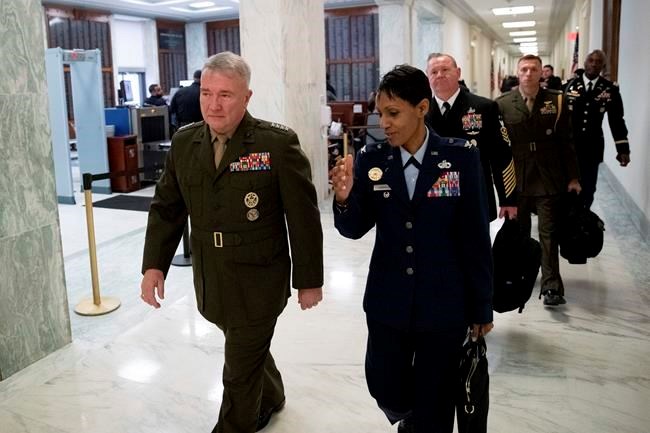WASHINGTON — The U.S. retaliatory airstrikes against militants in Iraq destroyed five weapons depots, but the top U.S commander for the Middle East acknowledged Friday that there are many similar sites that the U.S. has so far not hit because of potential civilian casualties and political sensitivities with the Iraqi government.
Marine Gen. Frank McKenzie said the U.S. decision to target the Iranian-backed Shiite militia group that killed American and British troops in a rocket attack this week sends a strong message to Iran and its proxies. But he said that as the threat of continued attacks remains high and tensions with Iran have not gone down, the U.S. is beefing up military assets in the region.
“What should now be obvious to everyone is you're not going to be able to fire those at a U.S. or coalition base, hurt or kill our people, and escape unscathed,” McKenzie told Pentagon reporters Friday. He said the U.S. has been aware of the weapons sites and knows where more are, but has exercised “restraint” in bombing them because in some cases strikes would kill "a lot" of civilians. He said the U.S. works with the Iraq military to take out the sites, but at times that doesn't work.
Kataib Hezbollah, the group the U.S. blames for the Wednesday attack at Camp Taji base that killed two U.S. and one British service members and wounded 14 other personnel, has not commented on the strikes, but another Iranian-backed group has vowed revenge.
The tit-for-tat strikes potentially signal another cycle of violence between Washington and Tehran that could play out inside Iraq. And they threaten to hamper ongoing U.S. negotiations with the Iraqi government to keep American troops in the country.
In fact, Iraq's military said three Iraqi army commandos and two federal police officers were killed in the U.S. strikes. And a Shiite endowment in the holy city of Karbala said one civilian in an airport complex being constructed by the endowment was also killed.
Asked about the Iraqi deaths, McKenzie said the U.S. talked with the Iraq military and they knew the U.S. attack was imminent.
“If Iraqis were there and Iraqi military forces were there, I would say it’s probably not a good idea to position yourself with Kataib Hezbollah in the wake of a strike that killed Americans and coalition members.”
Due to the ongoing threat, McKenzie said
He also said that Patriot air
The latest strikes mark a rapid escalation in tensions with Tehran and its proxy groups in Iraq, just two months after Iran carried out a massive ballistic missile attack against American troops at a base in Iraq. They came just hours after top U.S.
“The United States will not tolerate attacks against our people, our interests, or our allies,” Esper said. “As we have demonstrated in recent months, we will take any action necessary to protect our forces in Iraq and the region.”
According to the U.S. military, the locations of the strikes were largely around the Baghdad region. The strikes hit weapons storage facilities in Karbala, Al-Musayib, and Arab Nawar Ahmad and a missile storage and propellant production facility in Jurf al-Sakher,
Prior to the strikes top U.S. officials, including President Donald Trump and Esper had suggested retaliation was coming. And McKenzie told senators in a public hearing that the deaths of U.S. and coalition troops created a “red line” for the U.S.
Two U.S. troops and one British service member were killed and 14 other personnel were wounded when as many as 15 rockets hit the base Wednesday. The U.S. military said the 107 mm Katyusha rockets were fired from a truck launcher that was found by Iraqi security forces near the base after the attack.
Asked why there were no systems at Taji to intercept the rockets, McKenzie said that such systems are limited and can't be everywhere. He said to put a system there, he would have to take it away from another location where it's also needed.
Kataib Hezbollah was also responsible for a late December rocket attack on a military base in Kirkuk that killed a U.S. contractor, prompting American military strikes in response.
That in turn led to protests at the U.S. Embassy in Baghdad. They were followed Jan. 3 by a U.S. airstrike that killed Iran's most powerful military officer, Gen. Qassem Soleimani, and Abu Mahdi al-Muhandis, a leader of the Iran-backed militias in Iraq, of which Kataib Hezbollah is a member. In response to the Soleimani killing, Iran launched a massive ballistic missile attack on Jan. 8, at al-Asad air base in Iraq, that resulted in traumatic brain injuries to more than 100 American troops.
___
Associated Press writers Robert Burns in Washington and Qassim Abdul-Zahra in Baghdad contributed to this report.
Lolita C. Baldor, The Associated Press


